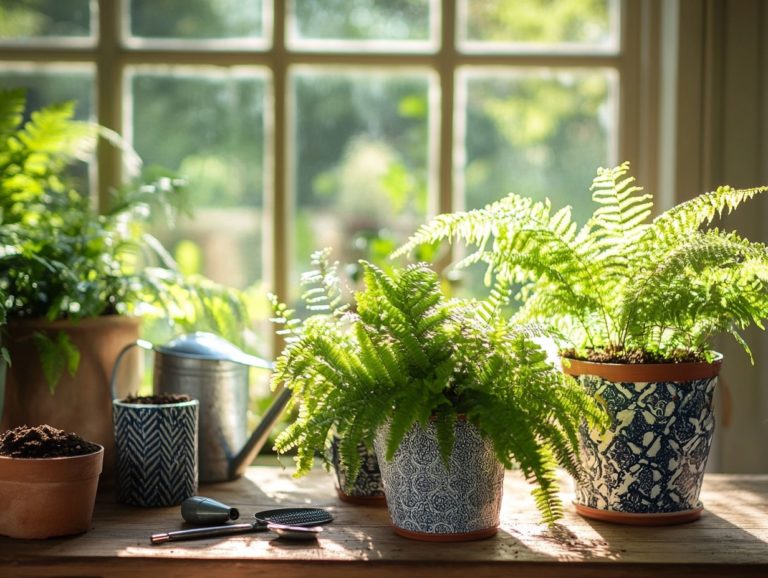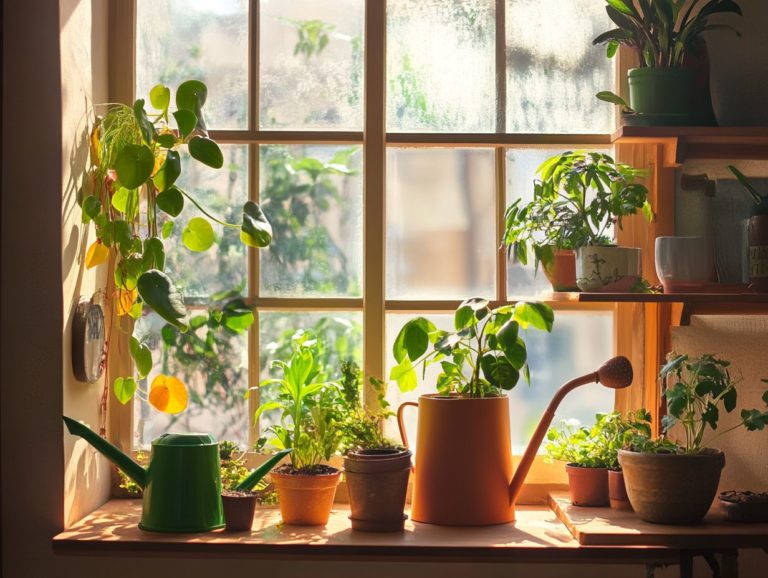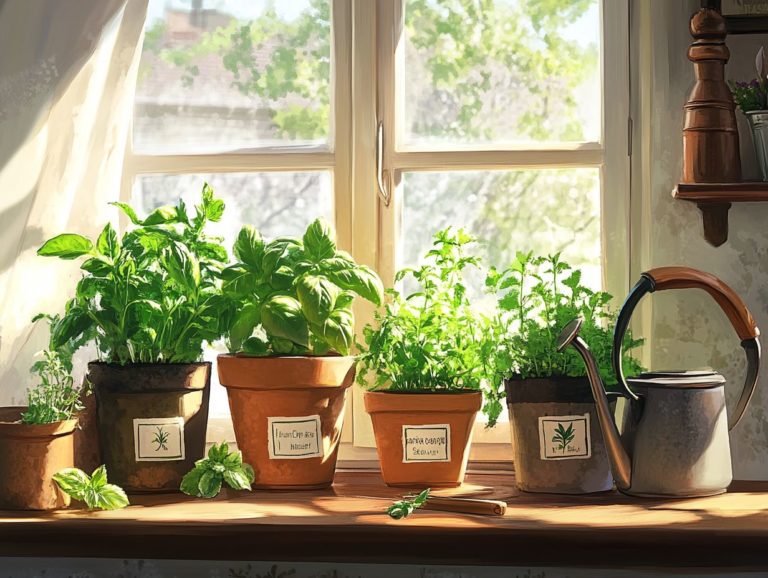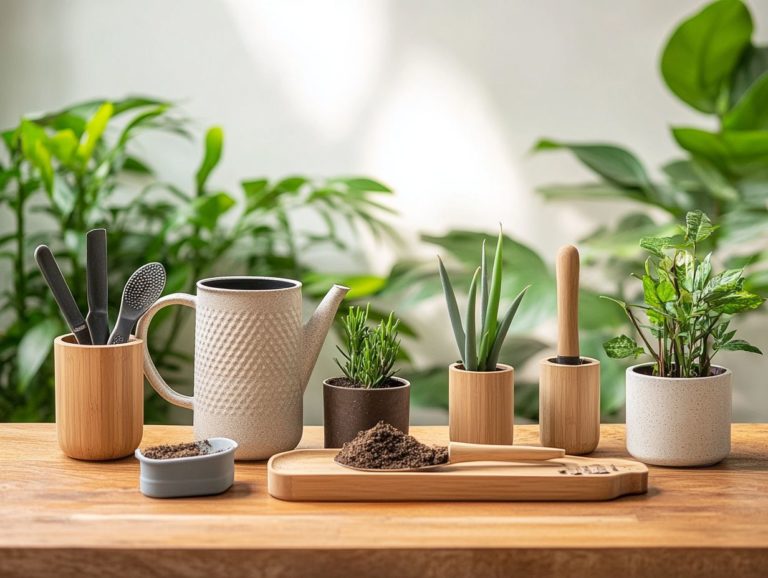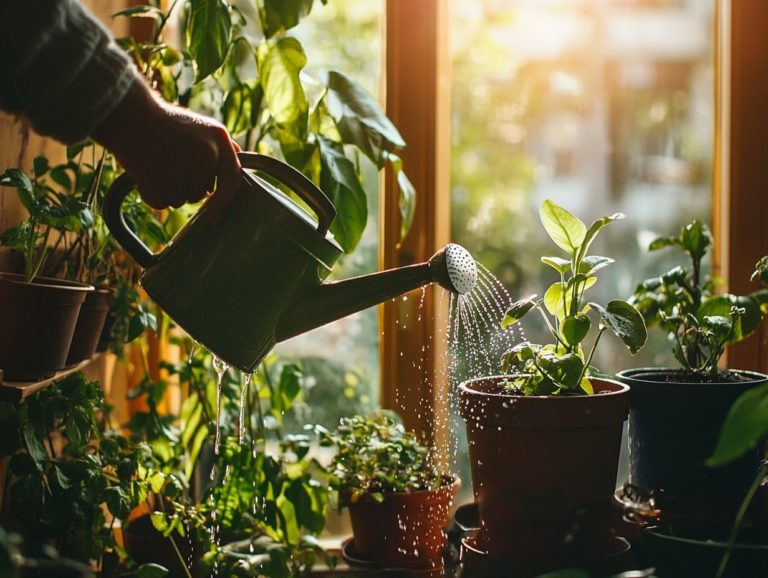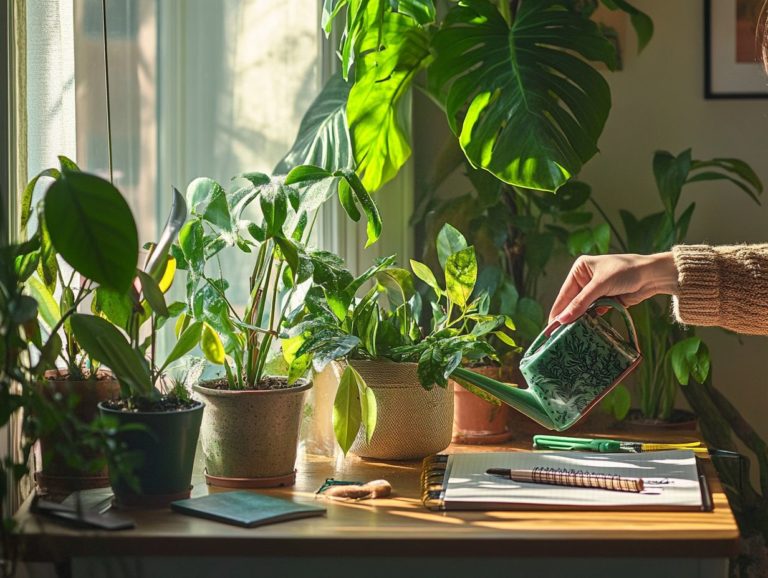What are the Most Common Indoor Plant Pests?
Indoor plants can infuse vitality and elegance into any space, yet they often attract unwelcome guests pests. Understanding these indoor plant adversaries and knowing how to identify them is essential for maintaining the health of your greenery.
In this article, you’ll discover the most common houseplant pests, signs that indicate an infestation, effective prevention strategies, and safe treatment options. It also delves into how to manage recurring issues, allowing you to relish your plants without the constant worry of pests.
Are you ready to protect your indoor garden and keep your plants thriving?
Contents
- Key Takeaways:
- What are Indoor Plant Pests?
- Common Types of Indoor Plant Pests
- Signs of Infestation
- Preventing Indoor Plant Pests
- Treatment for Indoor Plant Pests
- Dealing with Recurring Pests
- Frequently Asked Questions
- What are the Most Common Indoor Plant Pests?
- How can I identify if my indoor plants have pests?
- What are the consequences of having indoor plant pests?
- How can I prevent indoor plant pests from infesting my plants?
- What are some natural ways to get rid of indoor plant pests?
- When should I seek professional help for indoor plant pests?
Key Takeaways:

- Indoor plant pests are insects and other organisms that feed on indoor plants, damaging their leaves, stems, and roots.
- The most common types of indoor plant pests include mealybugs, spider mites, aphids, whiteflies, and fungus gnats.
- Signs of pest infestation include yellowing leaves, webbing, and small bugs on the plant. Effective prevention and safe treatment methods can help manage pests.
What are Indoor Plant Pests?
Indoor plant pests can be an ongoing problem for gardening enthusiasts like yourself, especially if you re devoted to nurturing houseplants. These pesky invaders can seriously affect the health and look of your indoor plants, which plays a vital role in your home gardening experience.
It s essential for you to familiarize yourself with the various types of indoor plant pests spider mites, aphids, mealybugs, and whiteflies so you can manage them effectively.
By employing natural pest control methods, such as insecticidal soap and neem oil, you can ensure your plants flourish while keeping your environment safe. You can enhance your pest management by using products like a natural bacteria that helps control pests. Swiftly identifying and treating these pests will go a long way in maintaining the vitality of your beloved houseplants.
Common Types of Indoor Plant Pests
You might encounter a range of indoor plant pests that can pose a significant threat to your beloved houseplants, including spider mites, aphids, whiteflies, and mealybugs.
Each of these pests boasts distinct characteristics and inflicts various types of damage on your plants, making accurate identification crucial for effective treatment. By familiarizing yourself with these common houseplant nuisances and popular indoor plant varieties, you’re taking the vital first step toward ensuring the health and vitality of your indoor collection and protecting them from potential plant diseases.
Identification and Characteristics
Identifying common houseplant pests requires you to recognize specific characteristics and signs of infestation on your indoor plants. For example, fungus gnats swarm near overwatered soil, spider mites leave fine webbing, and aphids produce sticky honeydew that fosters fungal growth. Accurate identification is essential for determining the right treatment and ensuring the health of your houseplants.
Mealybugs appear as small, white, cottony clusters on plant stems and leaf joints, signaling their presence. They can lead to yellowing leaves and stunted growth. Scale insects, on the other hand, may resemble small, dark bumps on stems or leaves. They also produce honeydew, which can result in sooty mold.
Effective pest recognition can be as straightforward as a visual inspection, or you may choose to use a magnifying glass for a closer look. Regular monitoring for changes and routinely checking the undersides of leaves can significantly enhance your chances of catching infestations early.
Signs of Infestation

Recognizing the signs of infestation is crucial for effective pest management and the health of your houseplants. Early indicators include wilting leaves, yellowing foliage, and the sight of visible pests on your plants.
If you see sticky residue or tiny webs, take action immediately, as these could signal an imminent pest issue that requires immediate attention. By staying vigilant and informed about these signs, you can tackle pest problems before they escalate into more serious plant diseases or damage.
Stay proactive and keep your indoor plants pest-free for a thriving green space!
How to Spot and Address Pest Infestation
Spotting and addressing pest infestations in your indoor plants requires keen observation and timely action. Begin by routinely inspecting the leaves, stems, and soil for any signs of pests or damage.
Pay special attention to the underside of the leaves, where many pests love to hide. Keep an eye out for discolored areas, sticky residues, or visible insects! Once you’ve identified any infestations, use effective soap designed to kill insects or neem oil, which is an oil from the neem tree that helps repel pests.
Regularly rotate your plants. Ensure proper air circulation to deter pests while keeping your plants well-nourished. By implementing these plant care tips and maintaining a vigilant eye, you’ll cultivate a thriving indoor garden that stands strong against pest threats, ultimately enhancing the beauty and vitality of your houseplants.
Preventing Indoor Plant Pests
Preventing indoor plant pests is vital for nurturing robust houseplants and achieving flourishing home gardening. Implement effective pest prevention strategies, such as maintaining ideal growing conditions and routinely inspecting your plants to diminish the chances of infestations.
Embrace companion planting and natural pest control methods. This will not only help keep unwanted pests at bay but also enhance the overall vitality of your indoor garden!
Effective Pest Prevention Strategies
Implementing effective pest prevention strategies is essential to maintain healthy houseplants and keep infestations at bay in your indoor garden. Clean leaves regularly. Ensure good air circulation! Utilize natural pest control methods to repel pests before they can establish themselves.
For example, position your plants away from direct drafts and maintain optimal humidity levels. This can significantly minimize the risk of unwanted pests like aphids and mealybugs. Enrich the soil with organic nutrients to support robust plant growth, making them less vulnerable to infestations.
Consider employing companion planting, where specific plants like African violets naturally repel pests. Introducing beneficial insects like ladybugs or predatory mites can help keep harmful pests at bay while fostering a balanced ecosystem.
These holistic approaches elevate your plant health and create a sustainable garden atmosphere. This discourages infestations and promotes growth, ensuring you can enjoy caring for houseplants without constant worry!
Treatment for Indoor Plant Pests
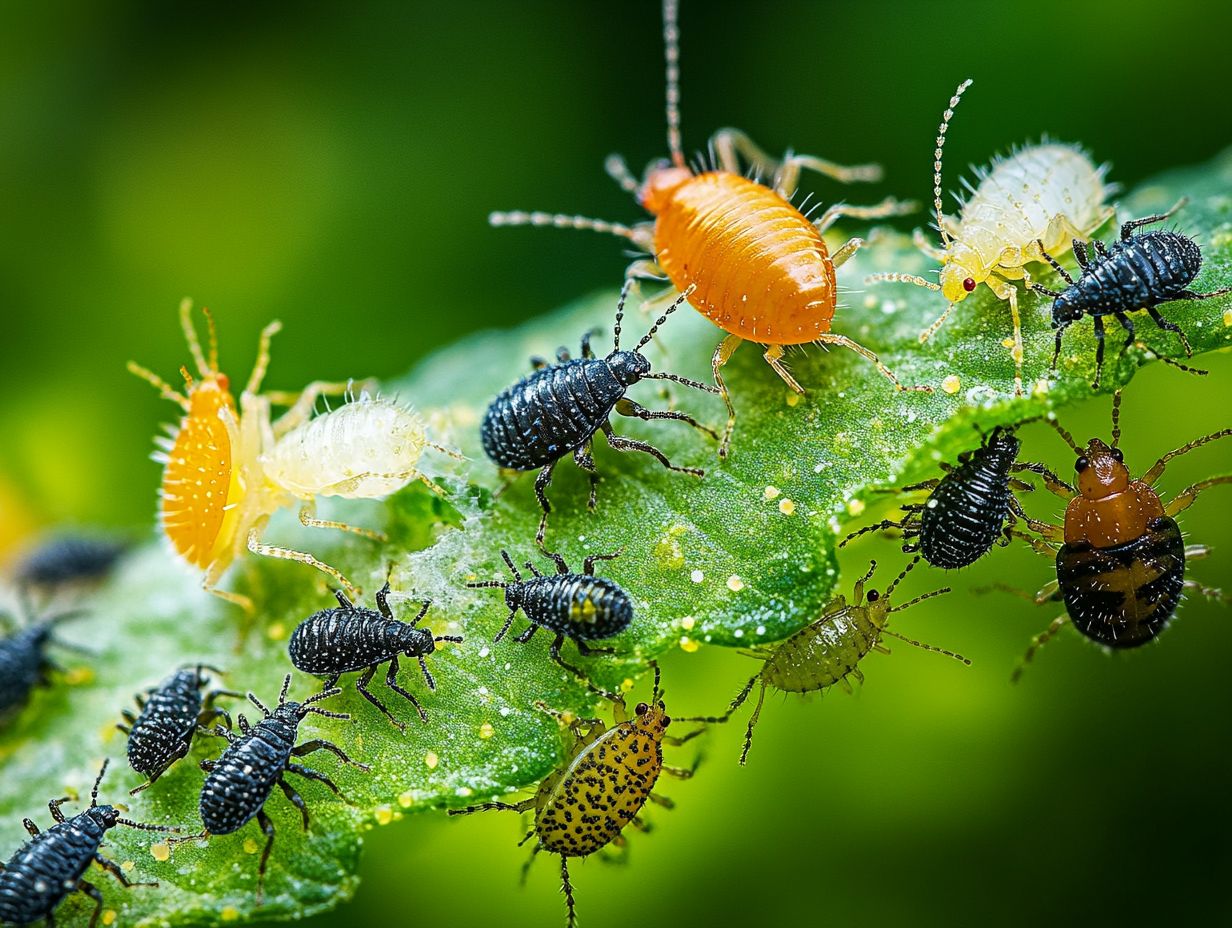
Treat indoor plant pests promptly to safeguard your houseplants from potential damage and ensure their ongoing vitality. You have a variety of pest control methods at your disposal, such as soap designed to kill insects, neem oil, and introducing beneficial insects like the ladybird beetle.
Use these pest management techniques to eliminate infestations and keep the integrity of your indoor gardening sanctuary!
Safe and Effective Pest Control Methods
Employing safe and effective pest control methods is crucial for protecting your houseplants while keeping the environment unharmed. Opt for alternatives to chemical pesticides to create a healthier living space while ensuring the vitality of your houseplants!
For example, introducing ladybugs can naturally manage aphid populations. Neem oil acts as a formidable deterrent against a variety of pests. Homemade sprays crafted from ingredients like garlic or hot pepper can also repel insects without risking your delicate plants.
These strategies not only protect your fragile houseplants but also promote a more sustainable gardening practice, fostering an indoor ecosystem where plants can thrive, free from the threat of harmful chemicals. Start implementing these tips today to keep your plants healthy and thriving!
Dealing with Recurring Pests
Addressing recurring pests in your indoor garden requires a strategic approach to ensure the ongoing health of your houseplants. By identifying the root causes of pest re-emergence such as environmental factors or poor plant health you can create more effective pest control methods.
A comprehensive, long-term pest management strategy minimizes the chances of future infestations from pests like spider mites and encourages thriving plant growth in your space.
Strategies for Long-Term Pest Management
Implementing long-term pest management strategies is essential for maintaining healthy houseplants and preventing future infestations. These strategies include:
- Regular monitoring
- Maintaining optimal conditions for plant health
- Utilizing natural pest control methods to deter pests before they arrive
By focusing on sustainable solutions, you can establish a resilient environment for your plants, supported by plant care tips that ensure their health and longevity.
Establishing a routine for checking signs of pests like discoloration or unusual spots on leaves empowers you to catch potential issues early. Attracting beneficial insects, such as green lacewings, ladybugs, and praying mantises, helps keep harmful pests at bay.
Integrating organic solutions like neem oil or insecticidal soap (a natural soap that targets pests) into your care regimen minimizes chemical exposure and promotes a safer environment for both your houseplants and yourself. This proactive approach leads to healthy plants that can withstand occasional challenges, ensuring your indoor garden flourishes beautifully.
Frequently Asked Questions
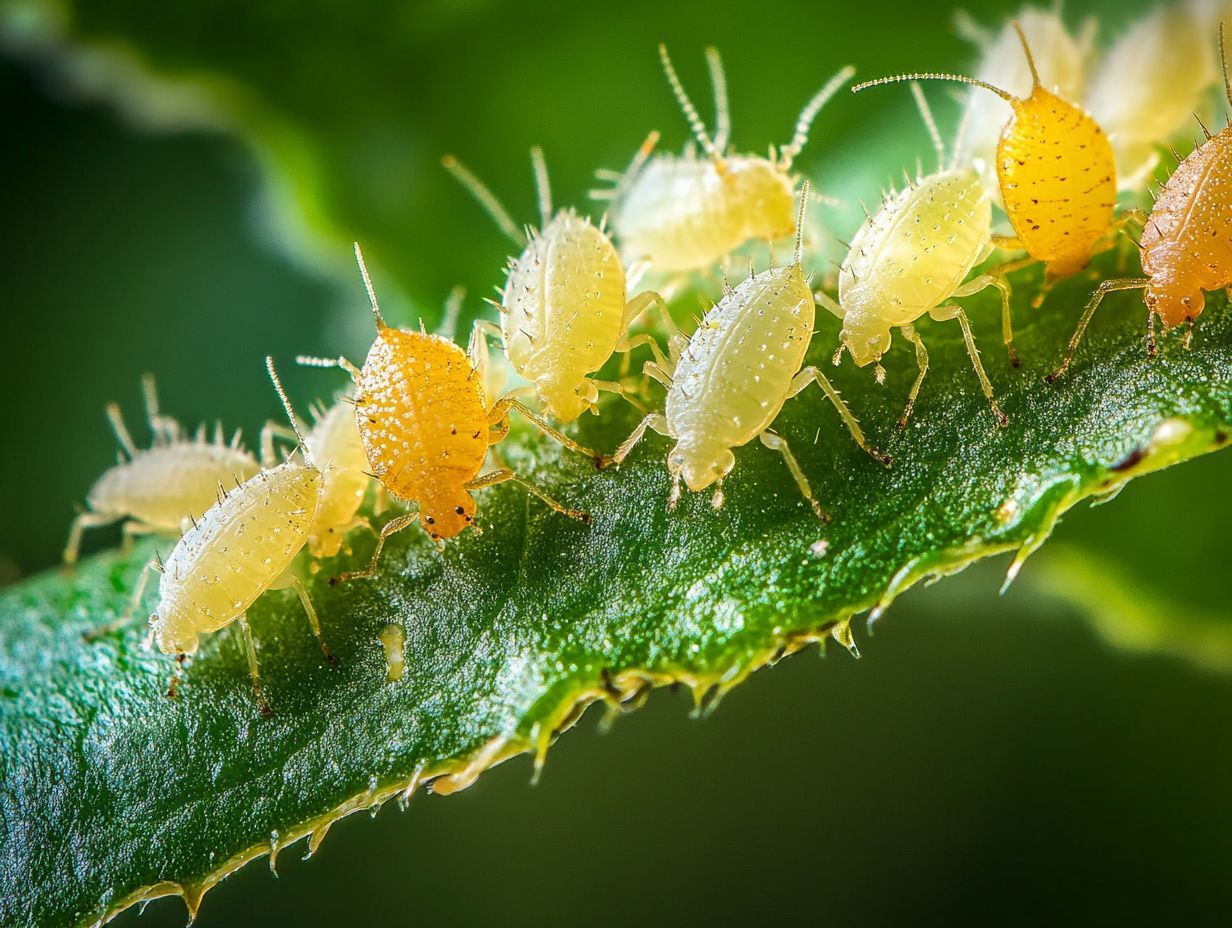
What are the Most Common Indoor Plant Pests?
The most common indoor plant pests include:
- Aphids
- Mealybugs
- Spider mites
- Whiteflies
- Fungus gnats
- Scale insects
These pests are crucial to monitor when caring for houseplants.
How can I identify if my indoor plants have pests?
Look for signs such as:
- Yellowing or wilting leaves
- Sticky residue on leaves
- Tiny dots or webs on the plant
- Small insects crawling on the plant
What are the consequences of having indoor plant pests?
Indoor plant pests can damage healthy houseplants, stunt their growth, and even kill them if left untreated. They can also spread to other plants, threatening your entire indoor garden.
How can I prevent indoor plant pests from infesting my plants?
Regularly inspect your plants for signs of pests, keep your plants healthy and well-maintained, and avoid overwatering and overfertilizing, as these can attract pests.
What are some natural ways to get rid of indoor plant pests?
Natural pest control methods include:
- Neem oil
- Insecticidal soap
- Rubbing alcohol to kill and repel pests
You can also introduce natural predators like ladybugs and green lacewings to your garden.
When should I seek professional help for indoor plant pests?
If your plant is severely infested, home remedies aren’t working, or if you have many plants, it’s best to seek professional help from a pest control expert.
Act now to protect your plants! Regular checks and preventive measures can save your indoor oasis from pests.

